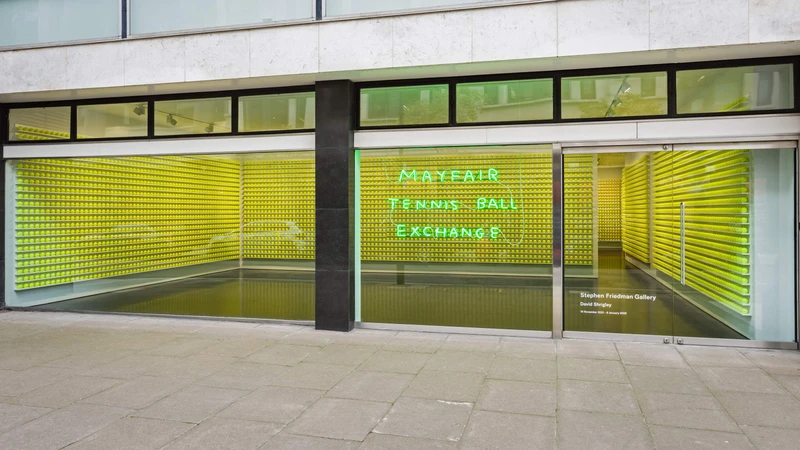David Shrigley: Mayfair Tennis Ball Exchange
19 Nov 2021-8 Jan 2022


Stephen Friedman Gallery is pleased to present David Shrigley’s eighth solo exhibition at the gallery, marking a long and fruitful collaboration over two decades. The British artist expands his conceptual practice with a new body of work comprising an interactive installation, large-scale neon and clock. A selection of works on paper will also be released online during the show. Characteristically deadpan in their humour, these quick-witted drawings satirise everyday occurrences and conversations. The exhibition precedes Shrigley’s major survey project, which opens at K Museum of Contemporary Art, Seoul, South Korea in December 2021.
The evolving installation ‘Mayfair Tennis Ball Exchange’ transforms the two spaces of Gallery 1. Visitors are invited to bring an old ball to swap with a new one from the numerous shelves that line the walls. Gradually the rows of yellow spheres are replaced with misshapen and discoloured forms that represent the joy of trade. Discussing the origins of this work, Shrigley explains: “My dog likes tennis balls. I throw them and she chases them. [Her interest is] more about exchange than possession.”
Toying with notions of commerce and community, the installation interrupts expectations of a gallery context. Participants are rewarded with a pin badge decorated with its title, in Shrigley’s distinctive handwriting. This text also appears in the gallery window in green neon letters that amplify the feel of a high street shopfront. Co-opting the aesthetic of a sign or advertisement, the ambiguous string of words undermines its informative format with mischievous humour.
The disruption to formal hierarchies embodied by the works in Gallery 1 shifts in the second space. A large-scale digital clock in the practical style of those at train stations or airports is visible from the street, mounted on the back wall. Although local time is set correctly, the display is illegibly out of focus. Whilst this useless object can be appreciated for its pure absurdity, it also hints at a slippage between personal experience and social consensus. Sparked by the artist’s own diminishing eyesight, the work speaks to those excluded from everyday conventions.
The exhibition is also accompanied by a film narrated by Shrigley, which documents the installation of works in the gallery.